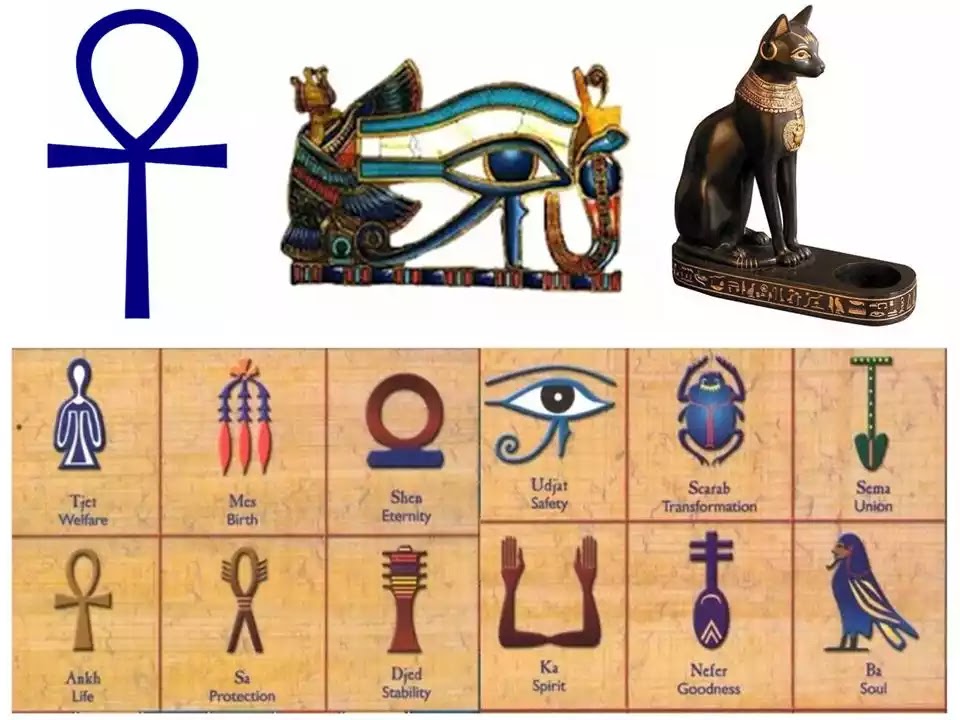Ancient Egyptian symbols are a fascinating topic. The Egyptians used symbols for a variety of purposes, including as a form of communication, to express their faith, and as a form of art. This blog post will explore some of the most popular Ancient Egyptian symbols and their meanings. From the Ankh to the Eye of Horus, read on to learn more about these intriguing symbols, where to find them during your tours in Egypt, and what they represented for the people who used them.
Tiet – The Knot Of Isis
Isis was the goddess of marriage, love, and fertility in ancient Egyptian religion. Her knot symbolized the eternal cycle of life, death, and rebirth. In many depictions, Isis is shown holding this knot in her left hand. You can visit the temple of Philae during Aswan day tours as it was built for the goddess Isis or simply add it to your Egypt classic packages to listen to the full story from our tour guide.
Feather Of Maat
The Feather of Maat is an ancient Egyptian symbol that represents truth, justice, and balance. It is often seen in hieroglyphs and artworks from the time period. The feather was also used as a weight in balancing scales, as a metaphor for justice. In some artwork, the Feather of Maat is shown being carried by a goddess or god, representing their role in dispensing justice. During your exploration of antiques in any Egyptian market, especially in the Khan El Khalili tour, you will find his symbol and can buy it. It’s one of the most interesting tours in Cairo day tours.
Crook and flail
The crook and flail are two ancient Egyptian symbols that were often used together. The crook was a shepherd’s staff that symbolized royal power, while the flail represented the pharaoh’s authority over agriculture. These symbols were often seen in reliefs and paintings of the king, and they were also carried by his attendants during ceremonies. There are also carved shapes in their coffins, which bear the symbol, such as the mask of Tutankhamun in the Egyptian Museum, it’s from the must-see attractions in Egypt luxury tours due to its importance.
The crook and flail first became associated with the king during the Old Kingdom period. At this time, the king was seen as a divine being who ruled over all of Egypt. The crook and flail were thought to represent his power over both humans and animals. This symbolism continued into the Middle Kingdom when the pharaoh was considered a god-like figure who controlled the destiny of Egypt. You will notice the symbol in the temples of Luxor during the day tours in Luxor.
The use of these symbols declined after the New Kingdom, but they remained popular in art and literature. In modern times, the crook and flail are still used as ceremonial objects by some Pharaonic orders.
Deshret Crown
The Deshret Crown was a red crown worn by pharaohs in Ancient Egypt. It symbolized the power and authority of the pharaoh, as well as the desert sun god Ra. The crown was often decorated with images of cobras or other symbols of power and strength. It’s the crown of lower Egypt that king Narmer seizes it.
Hedjet Crown
The Hedjet Crown was a white crown used by the ancient Egyptian rulers. It was thought to represent Upper Egypt and was often worn by the pharaohs. The name “Hedjet” is derived from the Ancient Egyptian word for “white”. The Hedjet Crown was also known as the White Crown and the Uraeus (cobra) Crown.
Pschent Crown
The Pschent crown was a double crown used by the ancient Egyptian pharaohs. It combined the White Crown of Upper Egypt and the Red Crown of Lower Egypt into one, symbolizing the king’s power over all of Egypt. The Pschent crown was often depicted in art as being worn by the goddess Isis. King Narmer unified upper Egypt and lower Egypt and wear the two crowns, the capital of Egypt then became Memphis city.
Tree of Life symbol
The Tree of Life is an ancient Egyptian symbol that represents the cycle of birth, death, and rebirth. The tree is often depicted as a palm tree, but it can also be represented as a sycamore tree. The tree has roots in the underworld and branches that reach up to the heavens. The tree leaves are said to be the food of the gods.
The Tree of Life symbolizes hope and regeneration. It is a reminder that even though life may end, it will always begin anew. The Tree of Life is a powerful symbol of growth, fertility, and eternity.
Seba Egyptian symbol
Seba was one of the most important symbols in ancient Egypt. It represented the sun and was often used as a symbol of power and strength. Seba was also associated with the god Ra, and was often seen as a protector of the king. See the symbol and know the full story in your Egypt travel packages to Karnak Temple.


Comment (0)